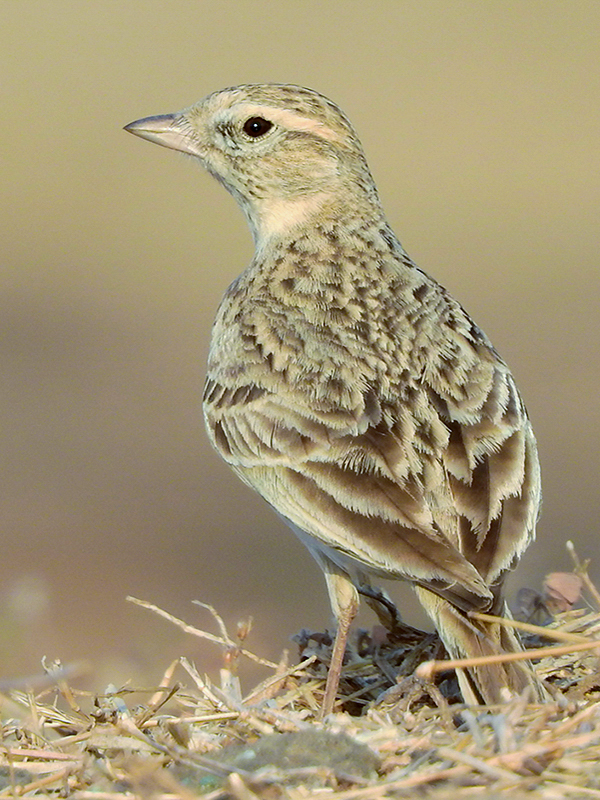
Photo © Shantanu Kuveskar
The greater short-toed lark (Calandrella brachydactyla) is a small passerine bird. The current scientific name is from Ancient Greek. The genus name, Calandrella, is a diminutive of kalandros, the calandra lark, and brachydactila is from brakhus, "short", and daktulos, "toe".
It breeds in southern Europe, north-west Africa, and across the Palearctic from Turkey and southern Russia to Mongolia. During migration they form large, tight flocks that move in unison; at other times they form loose flocks.
The greater short-toed lark was described by the German naturalist Johann Leisler in 1814 and given the binomial name Alauda brachydactila. This lark is now placed in the genus Calandrella that was established by another German naturalist, Johann Jakob Kaup, in 1829. The specific name brachydactyla is from the Ancient Greek βραχυδακτυλος brakhudaktulos "short-toed" from brakhus "short" and daktulos "toe". The alternate name short-toed lark may also be used for three other species in the genus Calandrella. The Mongolian short-toed lark was formerly considered as a subspecies of the greater short-toed lark (as C. b. dukhunensis) until split in 2016 by the IOC. Formerly, some authorities also considered the red-capped lark to be either conspecific (as C. cinerea) with or a subspecies (as C. b. cinerea) of the greater short-toed lark.
Eight subspecies are recognized:
The syntypes of Calandrella hermonensis Tristram (Proc. Zool. Soc. London, 1864, p.434), 3 adult males and a juvenile, are held in the vertebrate zoology collection of National Museums Liverpool at World Museum, with accession numbers NML-VZ T15738, NML-VZ T17770, NML-VZ T17771 and NML-VZ T17773. The specimens were collected at the foot of Mount Hermon, Lebanon in June 1864 by Canon Henry Baker Tristram. The specimens came to the Liverpool national collection through the purchase of Tristram's collection by the museum in 1896.
Several subspecies have been named but there is considerable geneflow and the species itself forms part of a larger complex. This is a small pale lark, smaller than the skylark. It is dark-streaked greyish-brown above, and white below, and has a strong pointed bill that is pinkish with a grey culmen. It has a pale supercilium, dark patches on each side of its neck and a dark tail. Some birds in the west of the range have a rufous crown. The sexes are similar. The greater short-toed lark is paler than the Mongolian short-toed lark which also has a shorter bill. In winter they fly in large and compact flocks that swing in synchrony. Care must be taken to distinguish this species from other similar Calandrella larks, such as the Mediterranean short-toed lark.
The nominate form breeds in Europe (Iberia, France, Italy, the Balkans and Romania) and winters in Africa. Subspecies hungarica breeds in the eastern parts of Europe while rubiginosa breeds in north-western Africa. Subspecies hermonensis (sometimes including woltersi) breeds in Turkey, Syria and Egypt. Subspecies artemisiana (considered by some to be synonymous with longipennis) breeds in Asia Minor and winters in southern west Asia. Subspecies longipennis breeds in Ukraine, Mongolia and Manchuria and winters in South Asia mainly in the drier zone of north-western India.
The song varies between a dry twittering and a more varied and imitative melody. Flocks will often fly together to water in the mornings at favourite spots. In the evenings they roost in open ground, with each bird squatting in a small depression made in the soil.
All but some southernmost populations are migratory, wintering south to the southern edge of the Sahara and India. This species is a fairly common wanderer to northern and western Europe in spring and autumn. Populations breeding in the Iberian Peninsula winter south of the Sahara in Africa. Here they prefer crop land and dry pastures with short shrubs while the syntopic Mediterranean short-toed larks (Calandrella rufescens) prefer drier areas.
This is a common bird of dry open country and cultivation. It nests on the ground, laying two to three eggs. Its food is seeds and insects, the latter especially in the breeding season.
In colonial India, they were hunted for food as ortolans.
They visit parts of South Asia in large flocks during winter and are sometimes attracted to short grass areas along aerodromes and become a bird strike risk to aircraft.
Source: Wikipedia